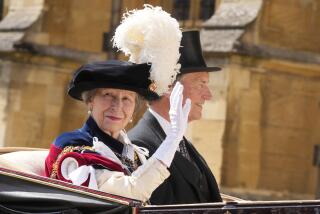Parade Passed Her By : In 1942, a Rose Princess Could Only Wave Goodby to Her Dreams
The Pasadena Rose Parade seems as certain to arrive as New Year’s Day itself. But, as Hermosa Beach grandmother Doris Burns Talbot learned more than half a century ago, even the most traditional holiday pageants can be torpedoed by world events.
In the fall of 1941, Talbot was crowned as one of the princesses of the 53rd annual Tournament of Roses. But after the bombing of Pearl Harbor on Dec. 7 of that year, military officials, fearful of an attack on the West Coast, canceled the New Year’s Day parade and moved the Rose Bowl to Duke University in Durham, N.C.
It was the only time the game has not been played in Pasadena.
Instead of waving to adoring subjects from a flower-bedecked float, the six teen-age princesses and their queen, all clad in regular street clothes, glumly rode a car past empty grandstands on Colorado Boulevard before attending a makeshift mini-parade at the Huntington Hotel.
For most of the intervening years, Talbot had tried to put the memories of those disappointing events out of her mind. But now, as her 70th birthday approaches, she is trying to reconnect with the women who were the Royal Court of 1942.
But Talbot has discovered that it isn’t easy to recapture a lost experience: “Everybody has tried to forget it. It was just easier to block it out. It’s almost like it didn’t really happen.”
In 1941, Talbot--then Doris Burns--was an 18-year-old mathematics major at Pasadena Junior College. A resident of Temple City, she had seen many Rose Parades over the years. But she says she had no particular ambitions to become a Tournament of Roses princess; she wanted to be a math teacher.
Judges from the Tournament of Roses, however, considered her princess material. At that time, officials held mandatory tryouts in the physical education classes at Pasadena Junior College. Every female student older than 17 was required to walk across a room and up a flight of stairs under the scrutiny of the judges.
Talbot, accustomed to feeling overshadowed by her older sister, says she was happily surprised to find her name on a list posted outside the dean’s office a few days after the first tryout.
Over the next few months, she would survive at least four more cuts before a Rose Parade official arrived at her house to inform her and her parents that she would be among the seven who would make up that year’s Royal Court.
The others were Helen Creahan, Patricia Lee, Clare Blackwell, Patricia Wiseman, Barbara Forbush and Dolores Brubach, who was later named queen.
Talbot said she didn’t become nostalgic about the other princesses and queen until early last year, when she realized that the 50th anniversary of their reign was approaching.
Interested in staging a reunion, she called the Tournament of Roses for help in tracking down the other women. She was disappointed to learn that the organization had no records of the women’s married names or addresses.
A look through regional phone books at the local library yielded the phone number of Barbara Forbush Kalmbach of Newport Beach, the only princess whose married name Talbot knew. Kalmbach, however, told Talbot that she wasn’t interested in reunions.
“I have no bad memories,” Kalmbach said later. “It’s just my life has moved on. I’m concerned with my family now and other interests.”
Talbot recalled that her selection as a princess “gave me a feeling that I wasn’t so bad--that I wasn’t really all that fat, ugly and stupid. It made me feel like I amounted to something. It was a good feeling.”
The princesses gathered for their first official portraits on Dec. 6, 1941. Dressed in short-sleeved white gowns, the young women were shown smiling demurely over armfuls of roses.
But the next morning, Japanese fighter pilots bombed Pearl Harbor, drawing the United States into World War II. Talbot remembers crying when her father, a Marine reservist and Los Angeles County sheriff’s deputy, received a phone call in the middle of the night telling him that he would be sent to the South Pacific.
Fearing that the Japanese had plans to attack the West Coast, military officials banned large gatherings throughout California. They ordered the Tournament of Roses to cancel its parade and the Rose Bowl game, which that year pitted Duke University against Oregon State.
Because the ban on public gatherings did not apply nationwide, Duke University agreed to be the site for the game. Talbot said some of the princesses hoped that they would be able to attend, but Tournament of Roses officials decided to keep them at home.
On New Year’s Day, the princesses and their queen “drove quietly down Colorado Boulevard, unnoticed by the few pedestrians on the deserted street,” according to a history provided by the Tournament of Roses. Later that day, they attended a reception in the dining room of the Huntington Hotel to witness a miniature parade of 33 tiny floral floats built by the hotel’s guests.
Talbot says she and the other members of the court sadly stood by as 4-year-old Sarah Pardee, the daughter of hotel resident Alan Pardee, was named the procession’s miniature queen. Talbot recalls feeling disappointed, even a little angry, that she and the other princesses would not have their day.
“It was like being left at the altar,” Talbot said. “I felt there was a big national cause and I felt that very deeply. . . . But it was disappointing not to be able to ride a float, and it was disappointing not to sit in a special box at the Rose Bowl.”
The Royal Court of 1942 would claim other distinctions, however. The Tournament of Roses declared the women members of a “Victory Court” and bestowed special titles on its princesses as part of the war effort.
Talbot was declared princess of defense stamps and bonds; Creahan was named princess of the armed services; Lee became princess of agriculture for defense; Blackwell was princess of health and welfare; Wiseman was princess of industry for defense, and Forbush was named princess of civilian defense.
While Royal Courts today take part in as many as 90 public engagements throughout the year, the Victory Court’s schedule of appearances was substantially shorter.
The princesses never received matching suits and gowns and, as far as Talbot remembers, they had only one group public engagement, at the now-defunct Los Angeles Breakfast Club. But they did make individual appearances, Talbot said. As princess of defense stamps and bonds, Talbot was frequently invited to local banks, where she was recruited to help sell defense stamps for the war effort.
“They had 25 cent stamps, and if you got $18.75 worth of them, you got a $25 war bond,” Talbot recalled. “You would fill up cards with stamps to get the bonds, but the bond couldn’t be cashed for 10 years.”
And in April, 1942, deputies at a Los Angeles County sheriff’s substation “crowned” her with a rolled steel helmet and gas mask--the same outfit worn by air raid wardens during the war.
“We were just sort of thrown out on our own,” Talbot said. “I don’t think you can understand or appreciate just how disorganized everyone was in the early days.”
Talbot soon moved on with her life. Forced to leave school because of illness, she never fulfilled her dreams of becoming a math teacher. She eventually married, had three daughters and settled in the South Bay, where she worked as a secretary for two aerospace companies.
Talbot attended the 1992 rose queen’s coronation but missed the Rose Parade itself. What pomp and ceremony there was to mark the 50th anniversary of the Rose Bowl game and parade of 1942 was reserved for the men who played in that year’s game.
Tournament officials set aside special seats for nearly 30 of the players in the 1942 Duke vs. Oregon State game. The month before, Duke University celebrated the 50th anniversary of the contest by inviting 35 former Duke players and 11 from Oregon State to its final football game of the 1992 season.
As far as Talbot and the rest of the Royal Court were concerned, though, the 50th anniversary came and went with little fanfare, much like the day it commemorated.
Tournament of Roses officials are prickly when asked why nothing was done to honor the 1942 Royal Court.
“The Tournament of Roses isn’t responsible for World War II,” said Bill Flinn, assistant executive director. “I’m sure the Tournament of Roses people who worked here for many, many years are very sorry (the New Year’s Day Parade was canceled). But we have to go by what the government tells us we have to do. . . . If somebody feels slighted, it certainly wasn’t intentional.”
Talbot insists that she holds no grudges. But she does believes that Tournament of Roses officials simply want to forget the non-parade of 1942. Still, she hopes that one day she and other members of that year’s Royal Court will meet and reminisce.
“We shared something special, and then sad, but it would be nice to get together with them,” Talbot said. “I don’t know whether the other princesses and the queen feel the same way, but I think some of them probably do--that it was something out there within our grasp and then it was dropped.”
More to Read
Sign up for Essential California
The most important California stories and recommendations in your inbox every morning.
You may occasionally receive promotional content from the Los Angeles Times.










